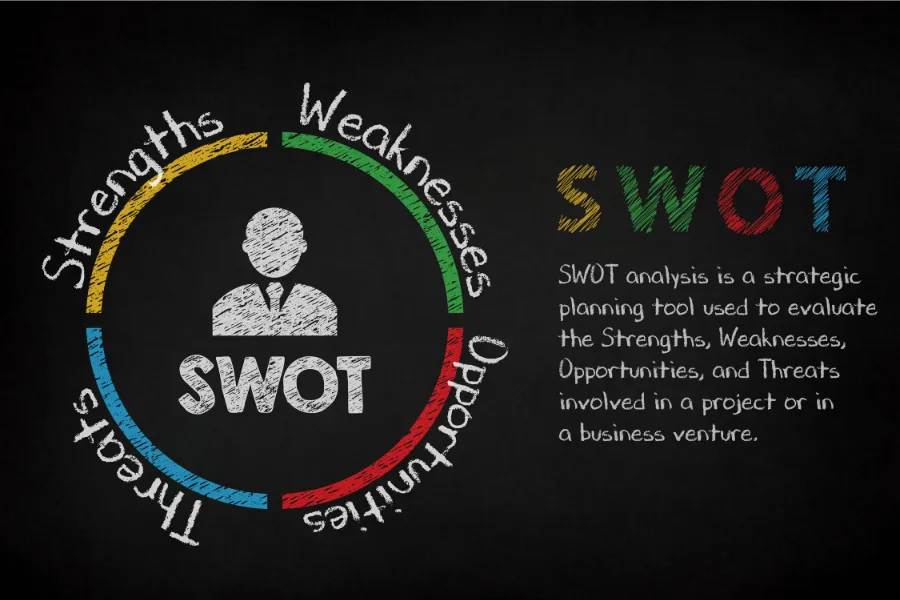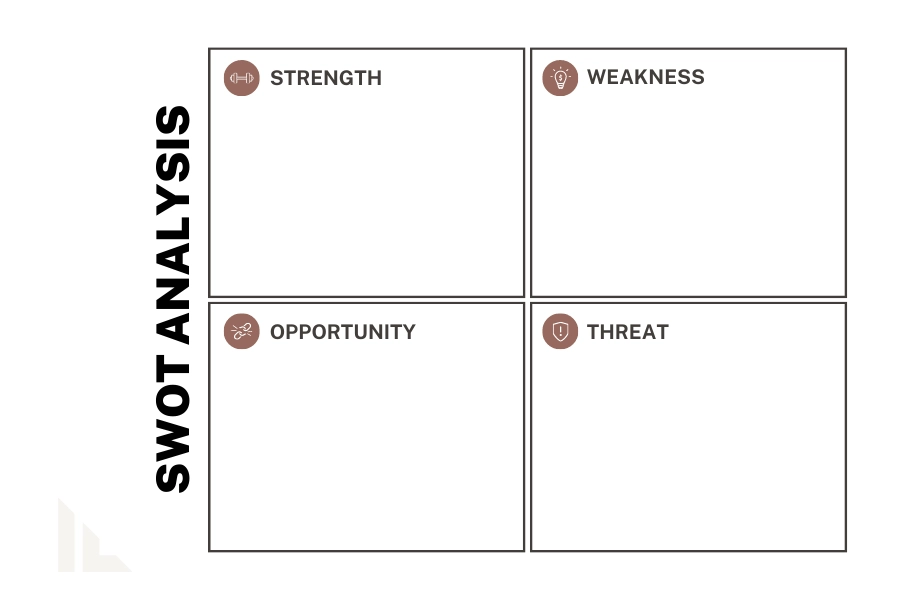Disclaimer: We sometimes use affiliate links in our content. For more information, visit our Disclaimer Page.
Are you looking to make more informed decisions that drive your organization forward? The SWOT analysis decision-making technique could be the answer you’ve been looking for. This popular and versatile tool helps you assess your options and make the best choices for your organization’s future. Read on to learn how to conduct a thorough SWOT analysis and transform your decision-making process.

What is SWOT Analysis?
SWOT analysis is a strategic planning technique used by businesses and organizations to identify their strengths, weaknesses, opportunities, and threats (SWOT). This information helps decision-makers evaluate their organization’s internal and external factors to develop effective strategies that create a competitive advantage.
The SWOT analysis matrix, also known as the SWOT matrix, is a simple visual tool divided into four quadrants, representing the four components of the analysis. By examining each quadrant, you can gain valuable insights into your organization’s current situation and make informed decisions to achieve your strategic goals.
Why Use SWOT Analysis for Decision-Making?
Incorporating SWOT analysis into your decision-making process is essential for several reasons:
- Efficient Decision Making: The systematic approach of SWOT analysis enables you to evaluate various aspects of your organization and identify the most relevant factors, making it easier to choose the best solution for a specific problem or goal.
- Informed Decisions: By analyzing your organization’s strengths, weaknesses, opportunities, and threats, you can make better-informed decisions that take into account the current business environment and future trends.
- Strategic Planning: The insights gained from SWOT analysis help you develop a strategic plan that maximizes your organization’s potential while minimizing risks.
Related:
Conducting a Thorough SWOT Analysis
To perform a thorough SWOT analysis, you need to evaluate your organization’s internal and external factors. Let’s explore each of these categories in detail.
Internal Factors
Internal factors include your organization’s strengths and weaknesses, which are primarily influenced by your unique resources, capabilities, and processes. Some examples of internal factors to consider include:
Strengths
- Strong brand reputation
- High-quality products or services
- Skilled and experienced workforce
- Efficient production processes
- Solid financial position and cash flow
- Unique technology or intellectual property
Weaknesses
- Limited product line or narrow market focus
- Inefficient processes or outdated technology
- High staff turnover or low employee morale
- Weak financial position or poor cash flow management
- Low market share or limited market presence
- Poor quality control or customer service
When analyzing your company’s strengths and weaknesses, it’s crucial, to be honest and objective. Identifying your organization’s true strengths and weaknesses will help you make better business decisions that address your specific needs and challenges.
External Factors
External factors encompass the opportunities and threats that arise from the external environment, such as market trends, competitors, and economic conditions. Some examples of external factors to consider include:
Opportunities
- New markets or customer segments
- New technologies or industry trends
- Partnerships, mergers, or acquisitions
- Changes in consumer preferences or demographics
- Increased demand for your products or services
- Positive changes in regulations or government policies
Threats
- Increased competition or new market entrants
- Economic downturns or changes in market conditions
- Negative changes in regulations or government policies
- Disruptive technologies or industry innovations
- Changes in consumer preferences or demographics
- Environmental or geopolitical risks
When examining the external opportunities and potential threats, it’s essential to consider both current and future factors that could positively or negatively affect your organization. This will ensure that your strategic planning is proactive and adaptable to a constantly evolving business landscape.
Related: How to Use the Evidence-Based Decision-Making Process
How to Create a SWOT Analysis Matrix

Once you have identified your organization’s strengths, weaknesses, opportunities, and threats, it’s time to organize this information into a SWOT analysis matrix. The matrix is divided into four quadrants, with each one representing one of the four aspects of SWOT analysis:
- Strengths (S): Top-left quadrant
- Weaknesses (W): Top-right quadrant
- Opportunities (O): Bottom-left quadrant
- Threats (T): Bottom-right quadrant
By organizing your findings in this manner, you can better visualize the relationships between the internal and external factors influencing your organization. This will enable you to develop strategies that capitalize on your strengths and opportunities while addressing your weaknesses and mitigating potential threats.
Developing Strategies Using SWOT Analysis
After completing your SWOT analysis matrix, the next step is to develop strategies that address the identified factors. These strategies should aim to achieve the following objectives:
- Leverage strengths: Maximize the benefits of your organization’s strengths and use them to create a competitive advantage.
- Mitigate weaknesses: Identify ways to address your company’s weaknesses and minimize their impact on your business operations.
- Seize opportunities: Develop plans to take advantage of new business opportunities and capitalize on market trends.
- Manage threats: Implement measures to mitigate potential threats and minimize their impact on your organization.
To develop effective strategies, consider the following approaches:
SO (Strengths-Opportunities) Strategies
These strategies involve using your organization’s strengths to exploit external opportunities. For example, if your company has a strong brand reputation and there is a growing market demand for eco-friendly products, you might consider expanding your product line to include sustainable offerings.
ST (Strengths-Threats) Strategies
These strategies aim to use your organization’s strengths to mitigate external threats. For example, if your company has a highly skilled workforce and faces competition from new market entrants, you could invest in employee training and development programs to maintain a competitive edge.
WO (Weaknesses-Opportunities) Strategies
These strategies focus on overcoming your organization’s weaknesses to capitalize on external opportunities. For example, if your company has a limited market presence but new markets are opening up, you could explore partnerships with established businesses to increase your market share.
WT (Weaknesses-Threats) Strategies
These strategies aim to minimize your organization’s weaknesses and reduce the impact of external threats. For example, if your company has poor cash flow management and faces economic uncertainty, you could implement cost-cutting measures and improve financial planning to enhance stability.
By using the SWOT analysis matrix to develop targeted strategies, you can improve your organization’s decision-making process and drive growth.
Related: Data-Driven Decision-Making Techniques
Practical Tips for Conducting a SWOT Analysis
To ensure that your SWOT analysis is accurate, comprehensive, and valuable, consider the following practical tips:
- Involve key stakeholders: Engage employees, managers, and other key stakeholders in the SWOT analysis process to gain diverse perspectives and insights.
- Use data and research: Support your findings with credible data, expert opinions, and industry research to ensure the accuracy of your analysis.
- Be specific and realistic: Focus on tangible factors that directly impact your organization, rather than abstract or hypothetical concepts.
- Prioritize factors: Determine the most critical strengths, weaknesses, opportunities, and threats to address in your strategic planning.
- Review and update regularly: Conduct regular SWOT analyses to stay informed about your organization’s evolving internal and external factors, ensuring that your strategies remain relevant and effective.
Related: Decision-Making Techniques for Managers
Real-Life Examples of SWOT Analysis in Decision Making
To better understand how SWOT analysis can inform decision-making in a real-world context, let’s explore two hypothetical examples.
Example 1: Tech Startup
A tech startup specializing in innovative home automation solutions is looking to expand its market presence and product offerings. The decision-makers conduct a SWOT analysis as part of their business analysis to inform their strategy.
Strengths:
- Unique and patented technology
- Strong in-house software development team
- Positive customer feedback
Weaknesses:
- Limited marketing budget
- Narrow product range
- Small market share
Opportunities:
- Growing demand for smart home devices
- Potential for partnerships with established tech companies
- New markets in emerging economies
Threats:
- Intense competition from larger companies
- Rapidly changing technology landscape
- Economic uncertainty
Using the SWOT analysis, the startup can develop strategies such as:
- Leverage their unique technology and strong software development team to create new, innovative products that cater to the growing smart home market.
- Explore partnerships with established tech companies to expand their market presence and reach new customers.
- Invest in targeted marketing campaigns to build brand awareness and increase market share.
Example 2: Manufacturing Company
A manufacturing company specializing in automotive parts is facing declining sales and increased competition. The management team conducts a SWOT analysis to inform their decision-making.
Strengths:
- Established relationships with key suppliers
- In-house engineering expertise
- High production capacity
Weaknesses:
- Aging production equipment
- High production costs
- Low market share in some regions
Opportunities:
- Growing demand for electric vehicle components
- Government Incentives Green manufacturing practices
- Expansion into new geographic markets
Threats:
- Increased competition from low-cost manufacturers
- Fluctuating raw material prices
- Uncertain global economic conditions
Based on the SWOT analysis, the manufacturing company can develop strategies such as:
- Invest in upgrading production equipment to improve efficiency and reduce costs.
- Leverage engineering expertise to develop components for electric vehicles, capitalizing on growing market demand.
- Expand into new geographic markets to diversify their customer base and increase market share.
By applying SWOT analysis in these examples, both companies can make more informed decisions and create strategies that drive growth and success.
Related: Steps to the Decision-Making Process as a Manager
Conclusion
The SWOT analysis decision-making technique is a powerful tool for organizations seeking to make better-informed decisions that address their unique strengths, weaknesses, opportunities, and threats. By conducting a thorough SWOT analysis, you can better understand your organization’s internal and external factors, enabling you to develop effective strategies that drive growth and create a competitive advantage.





